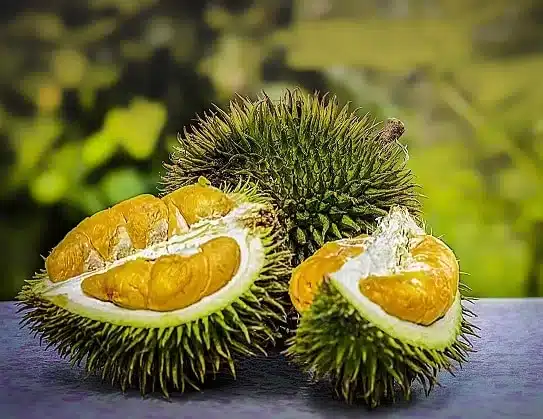The history of the durian is deeply intertwined with the cultures and regions of Southeast Asia, where the fruit is native. This unique and distinct fruit has a rich history that spans centuries and is closely connected to the traditions, culinary practices, and social aspects of the regions where it is cultivated.
Ancient Origins:
The durian (Durio) belongs to the Malvaceae family and is believed to have originated in the rainforests of Southeast Asia, encompassing countries such as Indonesia, Malaysia, Thailand, and the Philippines. Archaeological evidence suggests that durian consumption dates back to ancient times, with depictions of the fruit found on temple walls and artifacts.
Cultural and Culinary Significance:
Durian’s cultural significance is evidenced by its prominent role in traditional ceremonies, rituals, and celebrations in Southeast Asian cultures. In various indigenous communities, the durian is associated with fertility, abundance, and prosperity. It’s often considered a symbol of community and shared festivities, where families and friends gather to enjoy the fruit.
Historical Documentation:
Historical accounts of durian can be found in writings by European explorers and travelers who encountered the fruit during their journeys to Southeast Asia. For instance, the famous 16th-century Portuguese merchant and explorer Tomé Pires documented the durian in his “Suma Oriental,” describing it as “a fruit which, according to those who have tasted it, surpasses in flavor all other fruits of the world.”
With a formidable exterior and a distinct aroma that evokes strong reactions, the durian is a fruit that ignites fascination and intrigue among both its admirers and skeptics. Known as the “king of fruits,” it holds a special place in the culinary landscape, often sparking debates about its flavor, smell, and cultural significance. Let’s delve into the world of durian and uncover the reasons behind its unique allure.
A Feast for the Senses
Durian’s reputation precedes it, with its strong odor earning it a spot on lists of the world’s most pungent fruits. Some liken the smell to a blend of rotten onions, turpentine, and raw sewage. However, what makes the durian truly captivating is that behind this initially off-putting aroma lies a taste that’s equally intense but surprisingly delightful.
Flavor Profile
Beneath its spiky, armor-like shell lies a custard-like interior that carries a complex flavor profile. The taste is often described as a mix of sweet, savory, and slightly bitter notes. The flesh can range from creamy to fibrous, with variations across different durian varieties. Some enthusiasts savor the creamy, buttery texture reminiscent of rich custard, while others appreciate the slightly nutty undertones.
Cultural Significance
Durian’s cultural significance is deeply rooted in the regions where it’s grown. In Southeast Asia, especially in countries like Thailand, Malaysia, Indonesia, and the Philippines, it is cherished as a symbol of abundance, prosperity, and community. It’s often shared among family and friends during gatherings and celebrations.
Nutritional Value
Beyond its taste and aroma, durian is also packed with nutrients. It’s a rich source of dietary fiber, vitamin C, potassium, and antioxidants. While it’s relatively high in calories due to its natural sugars and fats, durian offers a satisfying and indulgent treat that’s best enjoyed in moderation.
Health Benefits
Durian’s nutrient content contributes to potential health benefits. Its fiber content supports digestive health, while antioxidants play a role in protecting cells from damage caused by oxidative stress. The vitamin C is vital for immune function and skin health. However, it’s important to note that durian is calorie-dense, so enjoying it as part of a balanced diet is recommended.
Culinary Versatility
Durian’s allure isn’t confined to its raw form. In various cultures, it’s used to create an array of culinary delights. From durian-flavored ice creams and pastries to savory dishes that incorporate durian in unique ways, this versatile fruit lends itself to creative exploration in the kitchen.
Durian Etiquette
For those new to durian, understanding the etiquette surrounding its consumption is essential. In some places, the fruit is not allowed in certain public spaces due to its strong smell. Durian aficionados also recommend pairing it with foods like sticky rice to balance its flavors.
The durian, with its audacious appearance, divisive aroma, and captivating taste, embodies the idea that food can be a multi-sensory experience. While it might take time for some to appreciate its unique qualities, the durian remains an essential part of culinary and cultural landscapes in Southeast Asia and beyond. From its cultural significance to its health benefits and culinary versatility, the king of fruits continues to be a subject of fascination, sparking conversations and culinary adventures around the world.

